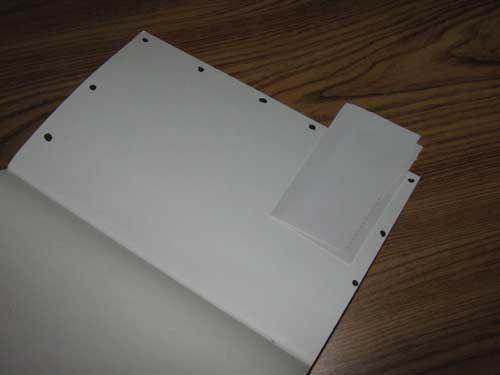Sometimes we find things that are so simple that they are bound to fly under our radar. But once you are reminded of the hiding place, it suddenly becomes as obvious as a mountain range.
Last week, while searching through law books bound for segregation units, I rediscovered an old trick of concealment - a page pocket. It was made from a blank page and the inside back cover of a book. This pocket can be utilized to store small items and correspondence.
Here’s how it works:
1. A prisoner borrows a book from the library. At the end of most law books one will find blank pages that are thicker than the pages with the text on them. These are called “end-paper”.
2. For optimal concealment, the prisoner will place some sort of fastening agent between the inside back cover and the very last page of end-paper. The pocket is less likely to be discovered if it is made with the end page adjacent to the inside back cover. This is because the end-paper mimics what the back cover would look like. Also, the back cover offers more support to a piece of end-paper than two connected end-paper pages could do.

3. I have seen end-paper alignment to the inside back cover that looks sloppy and is easy to detect. The true artisan can line up the pocket to make it look like it is fresh from the publisher.
4. There are many inexpensive and easy to find fastening agents within a prison. Soap, deodorant, and body fluids are some examples. (See Bouchard, Joe. “Contraband awareness: Fastening agents” www.corrections1.com March 11, 2011.) Another effective fastener is window tar. Window tar is the dark adhesive that one finds in most cells between the window frame and the glass itself. It is malleable, sticky and effective for the task of constructing a page pocket.
5. The recent example of the page pocket that I discovered used window tar. Whoever built this pocket seemed to have some basic knowledge of the craft. The person used small circles of window tar. They did not over do it by using a long, thick line. Rather, they spaced the adhesive about an inch apart. They did not waste tar by adhering the end page to the back cover where they meet at the binding, as that part was already bound by the publisher. The contrabandist seemed to know that using excessive tar could leave a greasy (and therefore detectable) residue. The spacing was judiciously done on the top and bottom parts of the page. But only half of the page for the outer part of the book was fashioned with the tar glue. That left the lower half of the right side of the end-page/inner back cover area as an inconspicuous opening.
6. Communication is key. If one prisoner is attempting to transmit information to another prisoner through the false page pocket method, both must be aware of which book and at what time it will be utilized. It can be tricky, though. Prisoners not officially in the scheme may borrow the book and inadvertently discover the page pocket and the information or small item within. In addition, staff may make the discovery and disable the page pocket while confiscating the information. So, the less obtrusive the pocket, the more likely the information or small contraband item will reach its intended destination.
7. All of this may not seem initially alarming to many corrections professionals. However if you can think of crucial communication done by prisoners then you can think of the dangerous scenario in which the page pocket may play a hard to detect the crucial part. Imagine how easily a razor blade or thin, sharpened plastic can be transported in a false pocket.
I did not find any actual contraband in the page pocket that I described. That leads me to believe that it was either a dry run or that the pocket had been used on previous runs. There was no discernible tobacco odor. There was no discoloration on the pages. All I could do was photograph the book, document the event, and inform staff of what I found.
Little things do mean a lot. And sometimes larger, obvious discoveries take the center stage. Still, it behooves us to remember the little trick of the page pocket. Realistically speaking, it would be very tedious and time-consuming to search every single book every single day. But is the awareness of this trick and communication of such to other staff that will improve our contraband control skills.














